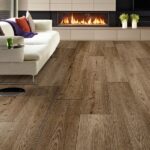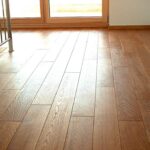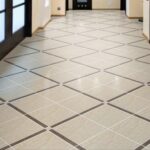Floor finishing is carried out during the construction of a building or during scheduled renovation work. Its purpose is not only to cover the screed or subfloor. Floor cladding is an important design element that directly influences the style and interior of a room. Thermal conductivity, the ability to withstand moisture, the effects of various factors of a chemical and mechanical nature depend on the finish. The range of coatings is large, but not all of them are suitable for a particular case. To make the right choice, you should familiarize yourself with the features, installation methods, pros and cons of each material.
Main requirements for flooring
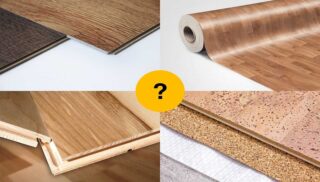
The floor covering is the most loaded surface. People walk on it, furniture stands and moves, various objects fall, liquid is spilled, wet cleaning is carried out regularly.
In order to withstand such loads and not lose their properties, materials must meet the following requirements:
- Wear resistance. This concept assumes the preservation of presentability and performance with prolonged and constant contact with heavy, chemically active and abrasive substances.
- Ecological cleanliness. Release of harmful substances during heating and burning is not allowed.
- Resistant to dampness. On a coating with hydrophobic properties, fungus and mold do not develop, and there is no unpleasant odor.
- Presentable appearance. This must be approached thoughtfully and for the future. After installing large cabinet furniture, replacing the coating may become impossible.
- Do-it-yourself styling. On the one hand, this is labor and time, on the other - cost savings, quality assurance and the acquisition of invaluable skills.
- Safety. We are talking about the durability of the coating and the absence of the risk of slipping, tripping or injuring yourself on unevenness.
Prefabricated coatings are subjected to test tests, the results of which are indicated by marking with the value EN 13329. In the absence of such symbols on the product, it is better to refuse it.
Varieties of flooring and their characteristics
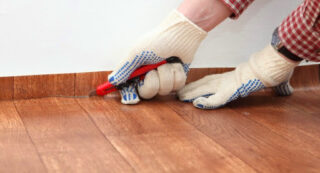
There is a wide range of floor coverings on sale, differing in type, composition, strength and abrasion resistance.
Depending on the layout of the apartment and the priorities of its owners, floor finishing options can be as follows:
- Linoleum. Roll finishing has been and remains one of the most popular finishing options. The reasons for this lie in its low cost, ease of installation and maintenance, water resistance and the possibility of laying on curved bases. The downside is that the material is easily torn and cut. Distinguish between roll and piece (tiled), synthetic and natural models, with or without a backing.
- Laminate. This floor sheathing faithfully imitates natural wood, it is quite simple to assemble into locks. The products are distinguished by ease of installation, safety, maintainability and affordable cost. The peculiarity lies in the need to create a perfectly flat base and treat the joints with moisture-resistant impregnation.For use in everyday life, models of the 31-34 class of wear resistance are produced.
- Parquet. Parquet flooring is a classic with a long history of use. The material looks great, has high insulating characteristics. Due to its composition, it can be repeatedly renewed by scraping. A feature, but not a disadvantage, is the need to regularly update the surface impregnation of the dies using special tools.
- Tile. This material is a leader in the field of cladding places with high humidity and traffic. It is used in kitchens, corridors, bathrooms and balconies. The coating is durable, durable, waterproof and presentable. The tile is not afraid of chemical reagents, but it crumbles and bursts from impacts with hard objects. The solution to this problem lies in the use of a variety of this facing material - porcelain stoneware. This coating has a homogeneous structure and higher strength.
- Carpet. In fact, the same carpet or carpet, with the difference that it spreads over the entire area of the room with the edges closed with a plinth. Distinguish between natural and synthetic (nylon, polyester, acrylic and polypropylene) models made by woven and needle-stitching, with a pile height of 3-9 mm. The best solution would be to cover living rooms with carpet, but the most durable brands are also suitable for the hallway.
- Self-leveling floor. This option is universal, as it is equally successful for any room in the house. After hardening, the liquid polymer forms a strong monolithic board with high insulating characteristics. The fill can be solid, colored, or transparent. In the latter case, a background or a three-dimensional pattern is made on the base.
When choosing a flooring material, you need to clearly compare its technical characteristics, compliance with operating requirements and your aesthetic views. It is important to harmoniously fit the coating into the interior and create comfortable and safe conditions in the room.
Rules for choosing floor finishes

When deciding to sheathe the floor with this or that material, some factors should be taken into account regarding the type of coverage and the characteristics of the property.
Experts recommend adhering to the following rules:
- Finishing compatibility with the purpose of the room. Here you need to consider humidity, permeability, natural light.
- Durability. It is advisable to take material, the service life of which is not less than that of furnishings - furniture and overall household appliances. This will make it possible to replace both as needed.
- Applicable to ever-changing interiors. Wallpaper changes every few years, curtains and furniture too. It is advisable to take flooring in a neutral color scheme, which will be relevant in any setting.
- Possibility of self-assembly and repair. It is expensive to hire professionals and it is not always possible to supervise their work.
An objective analysis of all the criteria will make it possible to make the correct and comprehensively grounded choice.
Required tools and materials
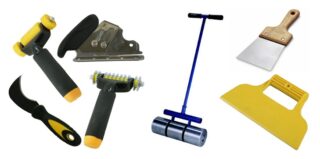
As a rule, to finish the floor with your own hands, a set of tools that most home craftsmen have is enough.
For linoleum:
- knife;
- glue;
- roller;
- notched trowel.
For laminate flooring:
- hacksaw;
- level;
- mallet;
- roulette;
- substrate;
- scissors;
- impregnation.
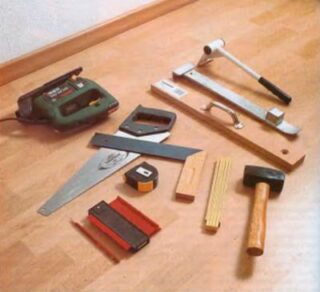
For parquet:
- paint brush;
- glue;
- mallet;
- mastic.
For tiles:
- Bulgarian;
- notched trowel;
- rubber spatula;
- plastic crosses;
- glue and grout.
For carpet:
- scissors;
- glue.
For self-leveling floors:
- mixer;
- pigment;
- needle roller.
In all cases, protective gloves and goggles should be worn.
The preparation for the installation of the floor covering is almost the same for all materials.It is necessary to eliminate all irregularities, fill up holes and cracks, treat the base with impregnation and antiseptic. Before carrying out wet work, you need to take measures to protect against contamination of interior elements.
DIY flooring technology
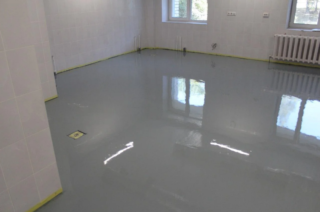
The laying technology for each type of floor covering has been worked out to the smallest detail:
- Linoleum is trimmed around the perimeter of the room, rolled into a roll, and then glued to the base as it unfolds.
- The laminate is laid on a substrate, a damper tape is placed around the perimeter. Each subsequent row is shifted by a third or half of the figure.
- Parquet is assembled individually or in blocks. The elements are glued to the pre-leveled and primed base.
- The tiles are laid on a special adhesive in longitudinal, transverse or diagonal orientation. The position of the fragments is fixed with crosses, the seams are rubbed with a special composition.
- The carpet is laid out over the entire area of the room, its edges are pressed against the baseboards. To glue the coating or not, it is up to the owners to decide.
- The filling mixture is applied to the base at the same time, after which it is leveled and processed with a needle roller.
With the right tools, skillful hands and knowledge of the theory of the issue, finishing floors with any type of material will not cause any complications for the master.

